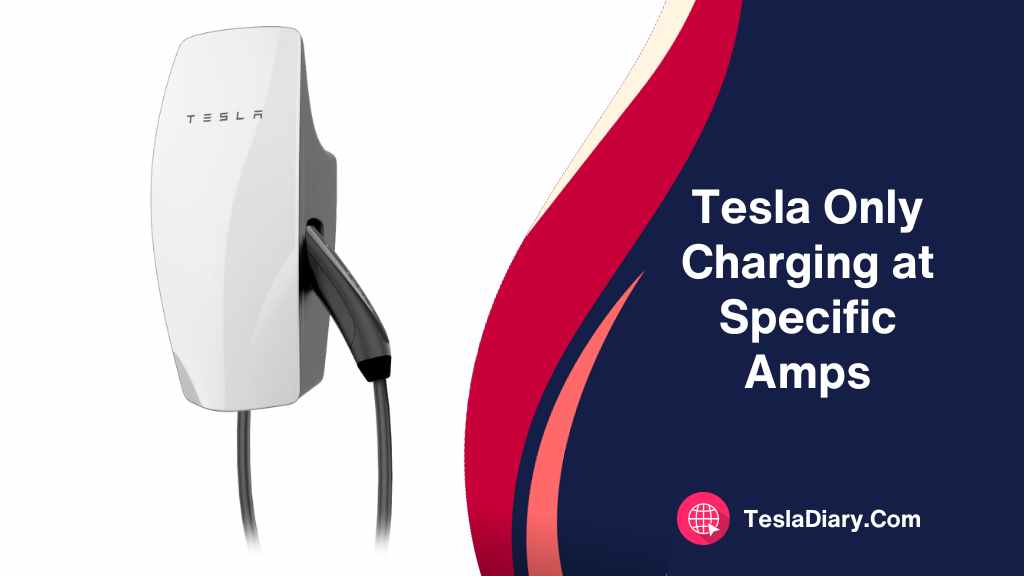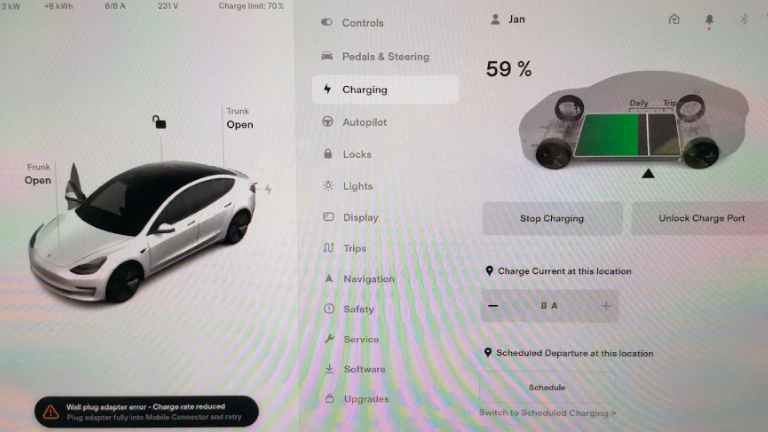Owning a Tesla is a thrilling experience, but it can be disheartening when your beloved electric vehicle charges at lower amperages than you expect.
Whether you’re using a Tesla Wall Connector, Mobile Connector, or another charging solution, encountering slower-than-anticipated charging speeds can be frustrating.
In this article, we will delve into the reasons behind this issue and explore how to fix it.

Understanding Tesla Charging
Before diving into the solutions, let’s first understand the fundamentals of Tesla charging. Tesla vehicles have onboard chargers with varying capacities, typically 11 kW, 7.7 kW, or 3.7 kW. These onboard chargers determine how quickly your Tesla can charge, but other factors also come into play.
Factors Influencing Charging Speed
Tesla Model:
Different Tesla models have different onboard charger capacities. For example, a Model 3 may have a 7.7 kW charger, while a Model S could have an 11 kW charger.
| Tesla Model | Onboard Charger | Circuit Breaker Recommendation for Wall Connector |
|---|---|---|
| Model S Model X Model Y Model 3 Performance Model 3 Long Range | 48 Amp (11.5 kW) | 60 Amp |
| Model 3 Rear-wheel Drive | 32 Amp (7.7 kW) | 40 Amp |
Charging Equipment:
The type of charging equipment you use affects charging speed. Tesla provides a range of options, from the Tesla Wall Connector to the portable Mobile Connector, each with its own capabilities.
| Charging Equipment | Max Current Draw | Charge Speed (per 15 minute) |
|---|---|---|
| Wall Connector | 48 Amp | 11 miles |
| Mobile Connector | 32 Amp | 1 mile |
| Supercharger | 615 Amp | 200 miles |
| Destination Charging | 48 Amp | 11 miles |
Electrical Service Capacity:
The electrical service at your location matters significantly. If your home has a limited electrical capacity, it can impact how much power your Tesla can draw.
Onboard Charger Limitations:
Your Tesla’s onboard charger has a maximum capacity, and it won’t charge faster than what it’s designed for. For instance, if your Tesla has an 11 kW charger, it cannot charge at 22 kW.
Diagnosing & Fixing the Problem
Before attempting to fix the issue, you must identify the root cause. Here are the steps to diagnose why your Tesla is charging at 30, 16, or 8 amps instead of the expected rate.
Primary Troubleshooting Tips
Consider these troubleshooting tips before you try anything:
- Check for any software updates for your Tesla. Sometimes, updates can resolve charging-related issues.
- Verify that the electrical outlet or charging station you’re using is compatible with your Tesla model.
- Reach out to Tesla customer support to discuss this issue. Sometimes, they can provide you with the best and cheapest solution.
Identifying the Issue
Check the Charging Cable:
Start by inspecting your charging cable. Look for any visible damage or wear and tear. A damaged cable can hinder charging speeds.
Verify Tesla’s Onboard Settings:
Check your Tesla’s charging settings. Ensure that the maximum charge rate is set correctly. You can adjust this using the Tesla mobile app or on the touchscreen in the car.
Inspect the Power Source:
Examine the power source, whether it’s a home outlet or a dedicated charging station. Ensure that it’s delivering the expected voltage and amperage.
Common Reasons & Solutions for Reduced Charging Speed
Incorrect Charging Settings:
Often, the issue lies in the settings. Make sure you’ve selected the correct charging rate in your Tesla. If you’re using a third-party charger, ensure its settings match your Tesla’s requirements.
Go to Controls > Charging > Charge Current at this location and see what Amp is set there.

Use the ‘+’ sign on the right to increase the current input rate to your Tesla battery. You can also use the ‘-‘ sign on the left to decrease the rate.
Cable or Adapter Issues:
A frayed or damaged cable can restrict charging speeds. Similarly, if you’re using an adapter, it might not be functioning correctly.
If you’re using an adapter, try a different one to ensure the problem isn’t with the adapter itself. Sometimes, adapters can become faulty over time.
Also, if your Wall Connector hardware is set at an incorrect Amp, your car will not be able to draw more than the specified Amp from that Wall Connector.
From my experience, whoever installs a separate circuit breaker for their Wall Connector causes their charging rate to fluctuate dramatically. So, I would recommend installing wall connector by a Tesla-certified technician who understands what he is doing.
Plus, you can check the issue by reading the Wall Connector manual.
Electrical Supply Limitations:
If your home’s electrical service is limited, it can cap the charging speed. Older homes with lower-capacity circuits might struggle to provide sufficient power for rapid charging.
This is not a DIY fix. So, I recommend consulting with an electrician who can assist you with this.
Installing a dedicated circuit for your Tesla charger can ensure that it receives a steady and reliable power supply, preventing any issues caused by shared circuits. So, this is something you might consider implementing.
Wrapping Up
Owning a Tesla is all about embracing the future of electric mobility, and charging should be a seamless part of that experience.
By understanding the factors affecting charging speed, diagnosing issues correctly, and following the recommended steps to fix them, you can ensure that your Tesla charges at the optimal rate.
Don’t let charging frustrations dampen your electric journey—take control and enjoy the full benefits of your Tesla.
Additional Resources

